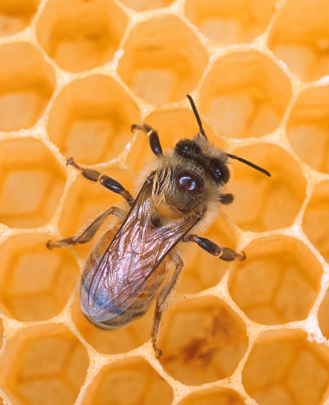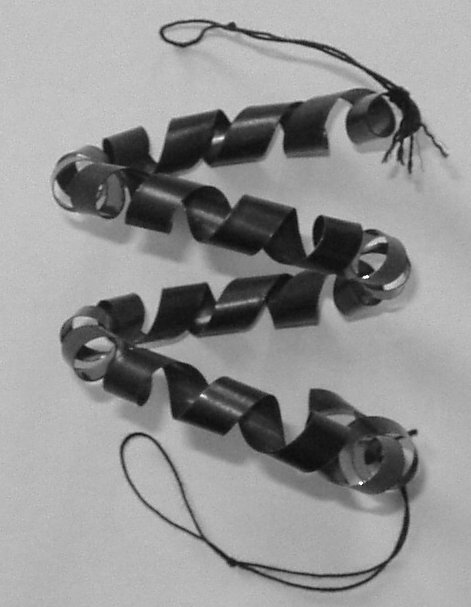Smooth as Silk (Honeybee Silk)
Image courtesy carolinabees.com
I’m not exactly sure how they managed it, but these industrious researchers “have managed to pull threads of honeybee silkfrom a stew of transgenically-produced silk proteins, meaning cheaper, stronger lightweight textiles and composites with myriad uses could be around the corner” (Dillow). They physically pulled these threads from the honeybees somehow (I guess they drugged them with smoke first? I always see people drugging bees with smoke to make them drowsy). These silk threads are fantastic because they consist of coils that are all coiled up, similar to our family phone cords back in the 1980’s. If you were to take enough of these coiled coil threads and weave them into textiles, the thought is, you’d be hard pressed to find a more durable bee-produced material.
Image courtesy University of Cambridge Engineering
So it probably takes a long time and is kind of inconvenient to pull silk threads out of honeybees all day, so researchers assembled some recombinant E. coli bacteria (it’s not just for gastric distress anymore!) who stepped up and made artificial construction of the silk thread possible. The bacteria cells were tweaked to produce the honeybee proteins (of which, you will recall, there are 4) and these, “with a little prodding, self-assembled into the proper structure to mimic honeybee silk” (Dillow). So now we can make this strong insect silk in mass quantities, because recombinant E. coli doesn’t break for lunch.
This also means I can look forward to featuring honeybee silk textiles, lightweight composites for use in marine construction and in aviation in the coming years! I’m so excited. I’m so … scared.
WU XING:
This entry is about protein, essentially, so I put it in the metal category because it just feels tough and durable and kind of ductile like metal – although I am not sure yet if this silk is any of these things. What do you think about that?
Cited:
Atkins, William. “Artificial Silk Could be the Bee’s Knees.” iTWire.com 02/03/10. Accessed 02/02/10. URL.
Dillow, Clay. “Tough, Lightweight Honeybee Silk Could Revolutionize Textiles, Composites.” Popsci.com 02/03/10. Accessed 02/03/10. URL.

















[…] […]
Bees are pretty amazing!apparently very fuel efficient too-heard on NPR yesterday they can travel over 100,000mi on 1gallon o honey
Leave a Wordpress Comment:
Ads
Watch ARCHITERIALS Videos on vimeo
Like on Facebook
Twitter
Flickr
Hit Counter
Ads
Blogs
Green
Journals/Publications
Materials
Network/News
Offices/People
Resources
Science
Pages
Archive
RSS and Email Subscriptions
Tag Cloud
3D 3D printer AB FAB academic acid acrylic actuated matter adaptive adhesive adsorption aerogel air air conditioning alloy aluminum amnh antibacterial antifungal ants april fool's architecture architecture robot artificial skin autonomous aviation awesome bacteria bamboo bananas beer bench bend bending biennale biocomputing biodegradable biodegradeable biomaterials biomimetics biomimicry biominerals biopolymer birds blast blast-resistant block blocks blogs Bloom Box brazil brick bubbles bucky bulk metallic glass butterfly calera canvas carbon carbon fiber carbon nanotubes carpet cars ceiling cellulose cement ceramic chain link chair charcoal charlie sheen chemicals chiller clay cloth cloud cmu coils color color-changing communication compound computer concrete condensation conducting conductive context cool coral cracks crystal cyborg demakersvan design digifab dirt disaster dna dror drywall dutch dynamic EAP earth ecocradle ecolect e coli ecology ecoresin ecovative elastic electric electricity electrochromic electroluminescent electronic energy energy recovery environment evaporative cooling experiment fabric fabrication facade fiber fiberglass fiber optic fiber optics fibers film FIRE flexible flickr fly ash foam fungus furniture garbage gel geodesic dome geometry gfrp gilgamesh glass glass fiber glow glue gold graphene green greensulate gsapp gypsum hard heat heavy heidi klum helix hemp hexagon hidden high performance hive honeybee humidity ice India ink insulation interference Internet inventables invisible invisible ink jello jellyfish just add water kevlar kinetic korea lace lamboo laser lattice leaves LED leed LEGO light light emitting light transmitting liquid lo mein london Loop.pH machines magic magnetic marine material materials meatball melting memory metabolic engineering METAL metal panel metamaterial micro microsensor microtools military milk MIT moisture multi-layer mushrooms mycelium nano nanogel nanotech nanotubes NASA new noise non-metallic oil OLED OMA ostrich oysters packaging paint panel panels paper paperfoam paraffin wax particles particulates petroleum phase change phosphorescent pink PLA plastic platinum pm-10 poetry pollution polymer polymers porcelain power precast printed printing protein public quadror radiant rain rammed earth reclaimed recycled reflective refracting Rem Koolhaas resin robot robotics roof rubber rugged sand sealant sealer search segmented self-healing sensor shape memory silica silicon silk skin skittles slats smog soft solar solar cell solar cells solar paint solid solid state lighting sound spider spider glue spray stabilized sand stone stretch stretchable strong structural structure studio dror sun sunglasses super supercritical sustainable switzerland tags tape technology TED tensile TEXAS textile textiles texture thermal thermochromatic thin thin film thread tiger stone tile tiles timber tio2 tires toaster tokujin yoshioka touch touch-sensitive toxic transparent t shirts tulip ultra-thin university of akron university of connecticut upcycling virus voc wall wallpaper WATER web wet whale wires WOOD woodwool wool workshop
WP Cumulus Flash tag cloud by Roy Tanck and Luke Morton requires Flash Player 9 or better.
Recent Comments
Ads